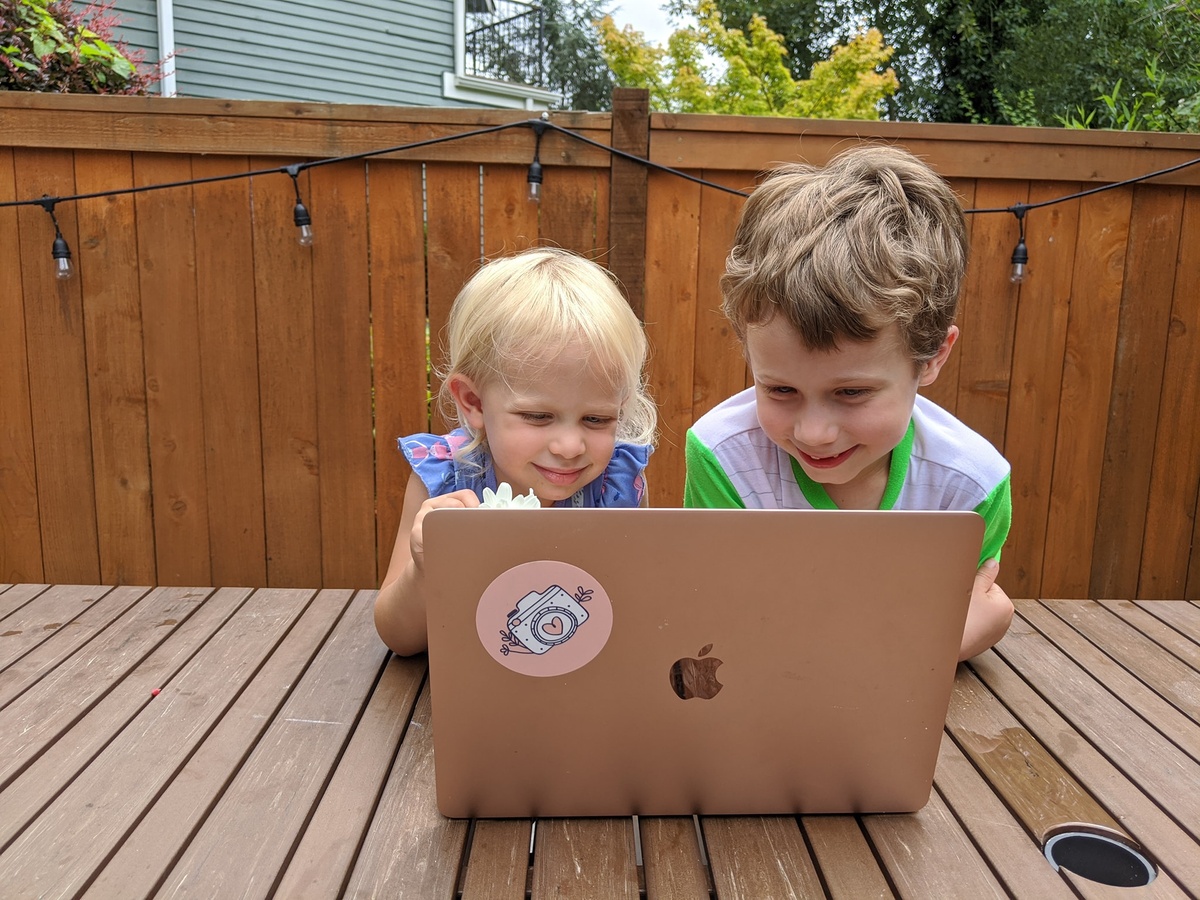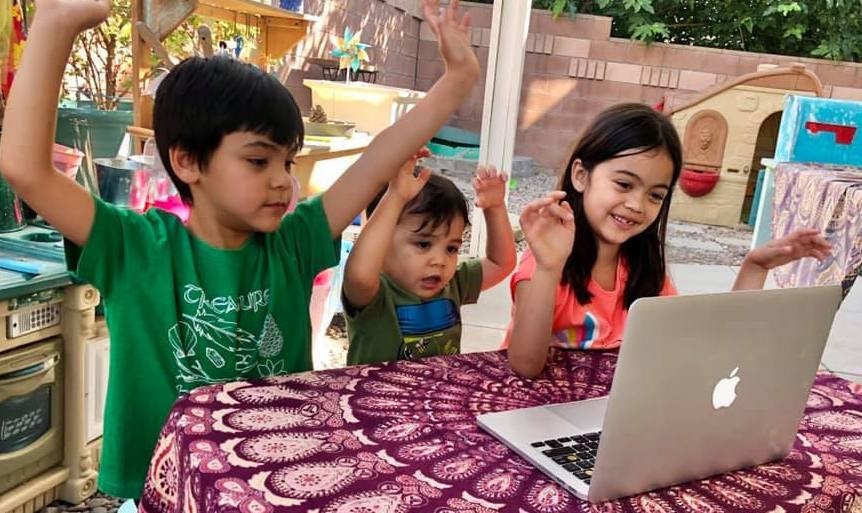As of today, I’ve been a parent for a decade, and so much has changed about me, my family and the world in these ten years. In 2010, I also got my first iPhone, and my relationship with screens really began. Though that relationship has matured, it’s always felt a bit uncomfortable, especially for the mom in me. What's the right balance for kids at different ages? How do we give kids boundaries and rules for screens when we don’t even know what they should be? For this next decade, and the fall we’re about to kick off, I want to find peace with screens.
Along the way, my fears of screens have been stoked by studies and articles that seem to scream that screens are damaging for kids. And, although we are still learning about what the ideal "dosage" of screen time is at each age, the American Academy of Pediatrics (AAP) clearly asserts that we should avoid screens outright for children younger than 18 months, and that we should limit and co-view screen experiences between 18 and 24 months of age. And, we have clear evidence that too much screen use later in a child's life correlates with real health problems like obesity and sleep disruption. Add to that the experience many of us have had watching kids we love seem to retreat into a world of screens as soon as they get a smartphone. It is as if we were all caught unprepared for the power of this technology, and it’s felt natural and important to push back against the overwhelming influence of screens.
At the same time, there is much to be gained from screens. They’re an undeniable part of our world: Screens have enabled me to meet, learn from, connect with and genuinely befriend people in ways that have changed my life. Tinkergarten—this beautiful, natural human experience would never be happening for families without the clever use of screens. I’ve also seen my kids enjoy wonderful on-screen experiences from reading with grandparents or beloved teachers on Zoom to observing animals they could never see on National Geographic to collaborating with friends to build new worlds with Minecraft.
It’s time to make friends with screens
Now that COVID happened, it’s no longer an option to wing it with screens. My quest for the one, definitive “right” way to manage screens has proven exhausting to me and confusing to my kids. At the end of the day, it's an art to find the balance with screens that works for each of our own families—I know I don’t have the space for extra worrying and waffling this fall, so it’s time to decide what screens are going to mean for us and go with it.
Expert insight
One book that has made a real impact on my family’s approach to screens is Anya Kamanetz’s The Art of Screen Time. Kamanetz lays out the range of studies that seek to define the impact of screens, and the research, as a whole, seems to say, “Be thoughtful and balanced” rather than either, “No worries,” or “No screens.” And, Kamanetz offers three helpful screen rules: enjoy screens; not too much; and do it together. Simple, flexible and powerful, these rules allow parents to develop a family’s relationship with screens and have given my own family a good starting place.
Back in April, shortly after quarantine became our reality and the opportunity for screen use seemed to skyrocket, the New York Times also supported us with the suggestion to focus on the “3 C’s”— child, content and context when worrying about screen time. You know your child, so consider what works uniquely for them. Try to find content that is engaging, enriching, and appropriate. Finally, be thoughtful about how your approach to screen experiences creates a context to make screen time enriching for kids.
More practical help, please!
Neither Kamanetz’s three rules and the three C’s are prescriptive, which makes them easy to adapt, but can also leave you with some work to do to actually apply them day to day. Below we’ve pulled together eleven next-level insights we’ve gained while trying to implement wisdom like the screen rules and the three C’s. We hope these prove helpful as you face the next round of learning in quarantine and help you and your children develop a relationship with screens that works for you!
Avoid mixed messages
Show kids that, when they are on screens, you feel good about them being there. Looking back, I know I have appeared apprehensive or even torn when saying “yes” to my kids or when throwing screens at them so I could join an unexpected meeting or get dinner cooked. Kids pick up on our feelings. And, kids either take on our screen discomfort as their own or start to see screens as a “forbidden fruit,” giving screens even more power. So, when you’re giving the OK for screens, give it whole-heartedly.
Look for quality
Kamenetz likens screen experiences to food. They range from nourishing for the mind to junk. How can you tell what is quality? First, there are screen experiences that just feel good, like conferencing or sending photos or messages with extended family.
We can look for who is creating it and why. As kids age, engage them in these questions, too. We now ask our 10-year-old to do the same, and hopefully we are teaching her to think critically about the media she consumes.
If an organization values or has on its team educators or child development experts, chances are they are designing media to engage kids and help them learn. Look for who they partner with, too—organizations that are truly committed to improving kids’ learning tend to align with others who are as well. We can recommend Khan Academy Kids and organizations included in Common Sense Media’s Wide Open School project as examples of truly educational, engaging screen time.
Seek interactive screen experiences
Nearly everyone enjoys a little passive screen time—recently, at the end of the day, a TV show is all I can handle. But when it comes to kids and screens, the more interactive and active their brains and bodies are during the experience, the better. If you’ve tried online classes with young kids, you’ve seen this for yourself. Online sessions that include music, movement and the chance to interact, ideally with a live and dynamic person, better engage and educate kids, especially young kids. That’s why we’ve designed our Tinkergarten At-Home Live classes with these elements in mind and why, as parents, we screen for these features every time.
Feel your way to what is “just right” for your family.
We know that there are risks associated with too much screen time, especially with respect to quality of sleep and obesity—and we all know in our guts that too much screen time is not good for any of us. But there is no official recommended dose, so it can be hard to know how much is too much. Try any of these ways to find your family’s “just right” amount:
Set reasonable time limits
The AAP recommends no more than one hour per day on screen for kids. Start by making sure that kids learn that there is a start and an end to a screen session. Before kids begin, you can establish with them how long it will be, and try to make the units of time something kids can understand. For example, it’s easy to use episodes—as soon as the episode ends, it’s time to transition to something off screen. Or, you can set a simple timer for 20 or 30 minutes, and kids will know it’s time to transition when the timer goes off. For kids ages two to five, an hour is, generally, the suggested dose of screen time for the day, so try to time that hour well and balance it with other experiences. Common Sense Media has some helpful guidance here, too.
Help young kids transition
We’ve all seen kids melt down or even tantrum when it’s time to shut off a screen—and it’s not their fault. Screens do a number on our minds—per Arianna Huffington, they are “hypnotic to our brains.” Considering that, it’s a huge ask for a child to get off a screen and move on to something new. Here some great ways to help kids transition.
- Stay as calm and soothing as you can, like you’d approach them when you need to wake them from a sleep.
- If you can, sit alongside them and join a minute or two before the screen has to come off, so you are already part of their world, making the transition less jarring.
- Give them a ritual like saying “goodbye” to the screen or putting the device somewhere special to “rest.”
- Try to schedule something offline that kids love right after screen time, whether it’s outside time, a particular toy or even snack time.
Balance screen time with green time
It may not be practical for you to track the minutes, but do try to stay consistent with how you approach screen time. When you flip flop or change the rules, kids get confused and rules start to lose their “oomph” altogether. Need an alternative to tracking time? Simply focus on building balance into your child’s overall schedule. Make sure that they take breaks, and that those breaks deliver what kids need most and what no screen can offer—time to be outdoors, to move and to use many different senses.
Slow down on the senses
Children need to not only strengthen each of their senses; they also need to learn to use them in concert with one another. And, there are senses beyond the 5 we learn about in kindergarten that have a tremendous impact on how kids feel, behave and are able to learn. Using screens narrows kids’ sensory experience to sight and sound alone—so, it’s imperative that you build in chances to use all senses. How best to do that? Play outdoors!
Keep screens in sight
Right from the start, we’ve encouraged our kids to be in shared spaces when they use their screens. It’s required us to invest in good headphones for all five of us, but it’s cut down almost entirely on the “sneaky screen time” behavior. And, more than once, one of the kids has mis-clicked, and we’ve been nearby to help them navigate new situations online—lessons you really need to be there to teach to keep kids safe.
Co-view and co-play
When you can, join your children for part of a screen session. Talk with them about what you are seeing or ask questions after the session to help kids process what they experienced. If you are not able to co-view during the day, set up a regular screen time ritual as a family like Friday movie night so you can experience screens together and start to teach kids how to think about stories, characters, and who is telling the story.
No-screen zones
Designating “no-screen” times and spaces—whether it’s dinner time, weekends or when family or friends are visiting—can help everyone, adults included, reset and keep a healthy relationship with screens. This old fashioned, screen-free kind of togetherness just can’t be beat, so schedule as much no-screen time as you need to unplug and really connect!

